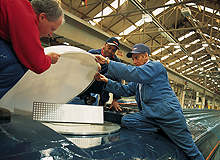
The prospect of onboard connectivity has long been a talking point in the rail industry. The benefits it poses, such as enabling customers to work whilst travelling, can be seen as a potent tool to increase passenger rates and consumer satisfaction. A growing percentage of train lines, particularly those that operate along commuter routes, provide WiFi connectivity free of charge in order to attract customers and keep existing ones happy.
However, problems with the technology’s efficacy, security issues and onboard etiquette threaten to derail projects before they have even started. A number of issues have threatened previous attempts to install WiFi receivers along the underground network, and the London Underground system has been famed for its user’s lack of communication. The likelihood is that opening the floodgates of mobile phone use would anger commuters who prefer a quieter journey.
How it works
The WiFi technology traditionally used on rail carriages involves the installation of multiple Wireless Access Points (WAPs) along the train in order to provide complete coverage.
The WAPs then use a combination of satellite and cellular phones links, usually HSDPA networks, in order to provide complete, uninterrupted coverage throughout the journey, even when through tunnels.
Connection speeds do, however, fluctuate. These depend on a number of variables, including proximity to the WAP, the number of users connected to any designated point and the train’s geographical location.
Users can connect to the network as they would to any home wireless network and, depending on the service, either surf free of charge or access a payment site to pay for an access code that entitles them to a set time period of access.
How well do you really know your competitors?
Access the most comprehensive Company Profiles on the market, powered by GlobalData. Save hours of research. Gain competitive edge.

Thank you!
Your download email will arrive shortly
Not ready to buy yet? Download a free sample
We are confident about the unique quality of our Company Profiles. However, we want you to make the most beneficial decision for your business, so we offer a free sample that you can download by submitting the below form
By GlobalDataWith a number of computers connected to an open network, security could become an issue. This has been worked on, and while these networks are considered as “open” no data is transferred between the individual computers using the network.
Coverage across train operators within the UK has grown rapidly. Virgin Trains offer WiFi connectivity on their Pendolino and Super Voyager trains powered by T-Mobile, with incremental passes available at different prices. National Express offer free WiFi access on all trains, as do Grand Central.
Heathrow Express trains offer on-train WiFi provided between Paddington and Heathrow Airport, also provided by T-Mobile, whilst Eurostar offers a range of WiFi hotspots at all major UK stations, including St. Pancras, Ashford International and Stratford International provided by Cityspace and The Cloud at no extra charge to Business customers.
Rail authorities in the UK have been keen to see WiFi coverage across all major networks and have gone as far as to fine franchise-holders for not complying. CrossCountry, who maintain the Cornwall – north-east Scotland line, were fined for failing to provide WiFi capabilities within their carriages. Having missed two deadlines enforced by the Department for Transport, CrossCountry’s suggestion that widespread dongle use implied that WiFi was no longer necessary failed to appease the governing body and the fine was upheld.
Speaking on the subject, Passenger Focus Director Ashwin Kumar said, “Research shows that business passengers value the ability to work on the train and 37% say that this is the key benefit of travel by rail.” This is substantiated by the addition of WiFi connectivity improving passenger rates.
Boosting traffic
In 2008, National Express registered a threefold increase along its East Coast Line after offering free WiFi connectivity. The line was previously operated by Great North Eastern Railway (GNER), who had enforced service charges of £4.95 per hour. Upon removing the charge when they took the line in January 2008, passenger rates rose from 30,000 to 100,000 for the month.
In 2010, the Association of Train Operating Companies (ATOC) claimed that part of a 6.9% increase of journeys over 2009 figures, in spite of particularly difficult operating conditions in December, was partly attributable to the continued roll-out of WiFi services.
There are now plans for UK’s Network Rail to follow the example set by other metro systems, such as the Paris Metro, and equip the London Underground system with WiFi and connectivity. A six month trial began in November 2010 at Charing Cross station platforms, enabling WiFi access through O2 Openzone connections. Free to BT Broadband customers and users of WiFi enabled mobile handsets, connectivity will branch across the ticket office and onto Bakerloo and Northern line platforms.
Whereas previous attempts to equip the tube with internet and mobile phone connections have failed, the success of this scheme will dictate its use across the network with London Mayor Boris Johnson aiming to ensure London has complete WiFi coverage in time for the 2012 Olympic Games.
WiFi on the underground
Systems are also in development that would allow connectivity in an underground travel environment. Wi-fi Rail has proposed a new patented radio frequency separation system that permits multiple radio signals in such environments. Multiple connectivity frequencys, including WiFi and mobile phone technology, can propagate through a common medium that is then separated at each repeater location.
The system is currently in use along specific lines of the Bay Area Rapid Transit (BART) metro system that serves the San Francisco Bay Area in the US. The company signed a twenty year agreement to offer end-to-end solutions and is currently working on phase two of a five phase installation programme which has delivered promising results. A continuous and stable wireless connection was maintained on railcars travelling at over 80mph, and the system currently serves 5.5 miles of underground tunnel and four underground stations.






